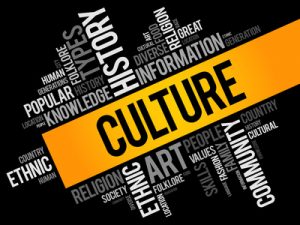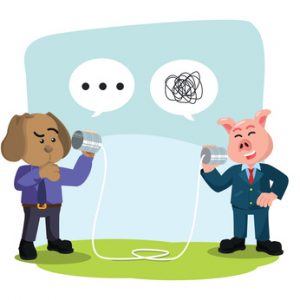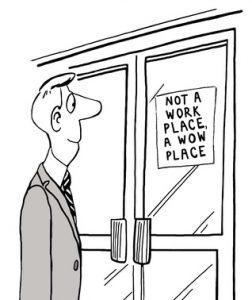Examples of American Cultural Values
 Cultural values are really the collective programming of our minds from birth. These values shape the beliefs, mind-sets, and practices that we often adhere to at work, home, and social settings. We looked at an example of a Hindu cultural value in our previous article and how that value shapes the beliefs, attitudes, and behaviors of that group. But what are some values that are distinctly American and have helped shape the American workplace for generations? The U.S. is a culturally diverse society, but there is a dominant culture that has developed over many years. Here’s a sample of a few American cultural values:
Cultural values are really the collective programming of our minds from birth. These values shape the beliefs, mind-sets, and practices that we often adhere to at work, home, and social settings. We looked at an example of a Hindu cultural value in our previous article and how that value shapes the beliefs, attitudes, and behaviors of that group. But what are some values that are distinctly American and have helped shape the American workplace for generations? The U.S. is a culturally diverse society, but there is a dominant culture that has developed over many years. Here’s a sample of a few American cultural values:
- Personal control over environment and destiny: The future is not left to fate and lies in our hands.
- Equality and egalitarianism: People have equal opportunities and are important as individuals, not based on the family they are from.
- Competition and free enterprise: Competition brings out the best in people and free enterprise leads to progress and success.
- The importance of time: The achievement of goals depends on the productive use of time.
- Change and mobility: Change equals progress, improvement, and growth.
When discussing cultural values, it’s important to remember there are no rights and wrongs. Chances are, each of us has been raised with a different set of values from our colleagues. Education is the key to understanding these differences, particularly when diverse groups of people are working together. To learn more about how cultural values shape your organization and to discuss conducting a cultural value assessment for your business, please call Leah M. Joppy and Associates at 301-670-0051 or email us at leah@lmja.com.
Effective Communication In The Workplace
 Have you ever walked out of a meeting scratching your head and wondering, “What was that all about? What exactly am I supposed to do? What’s the goal of our discussion?” We’ve probably all been there. It comes as no surprise that effective communication is one of the most important issues in the workplace. Strong communication helps everyone feel heard and understood, resulting in a positive, encouraging, and productive environment. On the other hand, ineffective communication causes ideas to fall flat due to lack of follow-through, frustration, and an overall decline in morale.
Have you ever walked out of a meeting scratching your head and wondering, “What was that all about? What exactly am I supposed to do? What’s the goal of our discussion?” We’ve probably all been there. It comes as no surprise that effective communication is one of the most important issues in the workplace. Strong communication helps everyone feel heard and understood, resulting in a positive, encouraging, and productive environment. On the other hand, ineffective communication causes ideas to fall flat due to lack of follow-through, frustration, and an overall decline in morale.
If you feel like your team is stuck in a communication rut or you’re just looking to improve your skills (and we all can!), here are some things to keep in mind and strategies to employ:
Give Undivided Attention: Whether it’s a group meeting or one-on-one, offering full attention to those you’re with goes a long way. How often have you had a conversation with someone who continuously looked down at his or her phone or seemed lost in another world? Lack of focus devalues conversations and causes people to tune out.
Remember to Listen: Listening may not sound like a component of communication, but it is one of the most important ingredients. Being an effective communicator means listening, as well as talking. It sounds easy, but it can take some practice. How often do you find your mind wandering during a meeting or a conversation? It can be helpful to keep a mental checklist of all the main points the other person makes. When the conversation is over, try to recall at least three important things the person said. Get in the habit of doing this until listening is second nature.
Be Mindful of How You’re Communicating: Body language and tone contribute a great deal towards the effectiveness of your message. Maintain a relaxed stance and facial expression, rest your arms by your sides rather than crossing them in front of you, and make eye contact. Remember that words only make up a fraction of your message.
Follow Up in Writing: A lot of information and ideas are thrown around during meetings and it can be challenging for everyone to remember what was shared. Prior to meetings, designate someone to take notes and then assimilate this information into a concise email. Having a follow-up and refresher is an important step to make sure everyone is on the same page.
Effective communicating is more than just talking; it’s about connecting with the people around you. It’s integral to team development, company culture, employee engagement, and innovative thoughts and ideas. If you’d like to improve the communication process in your office or are interested in doing a “wellness check”, we’re armed with lots of strategies and ideas to help. Please call Leah M. Joppy and Associates at 301-670-0051 or email us at leah@lmja.com to learn more.
Effective Communication With Remote Employees
 Remote work is becoming more and more common in the modern workplace and the number of remote workers is increasing every year. Technology has made it easier to embrace remote work, but it has also brought about new challenges when it comes to team communication. Here are some tips to help the wheels of communication keep rolling when you don’t work under the same roof:
Remote work is becoming more and more common in the modern workplace and the number of remote workers is increasing every year. Technology has made it easier to embrace remote work, but it has also brought about new challenges when it comes to team communication. Here are some tips to help the wheels of communication keep rolling when you don’t work under the same roof:
- Establish standards for communication to ensure everyone is on the same page.
- Make sure transparency is a priority. Share all documents, decisions, upcoming deadlines, etc. in one area.
- Find a balance between over-communicating and not communicating enough.
- Make sure new remote team members get to know the rest of the team via video chat.
- Use real-time communication technology.
- Be concise and get to the point at the beginning of messages!
- Always proofread and edit messages to avoid confusion.
- Give space when needed. If remote team members need to take a break from being accessible online to get something done, make sure they know they can do it.
Remote team members add another layer of challenge when it comes to workplace communication. But by using some strategic tactics, it doesn’t have to result in a communication meltdown! For more tips and advice on how to improve communication with remote employees, please call Leah M. Joppy and Associates at 301-670-0051 or email us at leah@lmja.com.
The Impact of Nonverbal Communication In The Workplace
 You’ve probably heard the familiar phrase, “it’s not what you say, but how you say it.” We’ve all been taught that good communication is the foundation of any successful relationship, whether personal or professional. But we may forget that it’s our nonverbal communication – our facial expressions, eye contact, gestures, posture, and tone of voice – that sometimes speaks the loudest.
You’ve probably heard the familiar phrase, “it’s not what you say, but how you say it.” We’ve all been taught that good communication is the foundation of any successful relationship, whether personal or professional. But we may forget that it’s our nonverbal communication – our facial expressions, eye contact, gestures, posture, and tone of voice – that sometimes speaks the loudest.
Consider the following example: As a staff meeting begins, project manager Jack shuffles into the room. He pulls at the sleeves of his rumpled shirt and his shoulders sag. He does not make eye contact with anyone in the room and is absorbed in looking over his notes haphazardly scratched on notebook paper. When he does speak, it’s difficult to hear him. He awkwardly clears his throat as he says, “Good morning, everyone. This will only take about a half an hour, but I’m going to walk you through some of the changes we can expect on our current project and what it means for all of us.”
But it could also go something like this: Project manager Jack walks confidently in the room. He stands tall with his shoulders back. His shirt is wrinkle-free and tucked in and his appearance is neat and professional. He directs his eyes around the room and makes sure that everyone is acknowledged. His notes are neatly on the table, but he doesn’t look at them in favor of his audience. As he begins to speak, his voice is clear, confident, and loud enough for everyone to hear. He smiles as he says, “Good morning, everyone. This will only take about a half an hour, but I’m going to walk you through some of the changes we can expect on our current project and what it means for all of us.”
The same words were used, but a completely different impression was made. It’s not what Jack said, but how he said it that changed. Only his appearance, tone, and manner were different, yet his nonverbal communication had an enormous influence on his team. Which version of Jack would you trust the most? The shuffling, difficult-to-hear person who won’t look you in eye? Or the confident, articulate person who acknowledges everyone in the room? Research suggests that we are more likely to believe a poor argument explained to us in a convincing manner than one based on sound facts and logic, but presented by someone who sounds uninterested and uninformed. That’s the power of non-verbal communication.
Have you thought about the impact of nonverbal communication on your workplace? We can show you how to improve the way you and your team use nonverbal communication through a variety of fun team activities and exercises. Please call Leah M. Joppy and Associates at 301-670-0051 or email us at leah@lmja.com to learn more.
Types of Nonverbal Communication
 When we interact with others, we continuously give and receive wordless signals. All of these nonverbal behaviors – the way you listen, look, move, and react- send strong messages, some positive and others negative. In many instances, what you say and what you communicate through your body language may be two totally different things. When confronted with these mixed signals, your audience has to choose whether to believe your verbal or nonverbal message. Often, nonverbal communication is the winner because it’s a natural, unconscious language that conveys your true feelings and intentions.
When we interact with others, we continuously give and receive wordless signals. All of these nonverbal behaviors – the way you listen, look, move, and react- send strong messages, some positive and others negative. In many instances, what you say and what you communicate through your body language may be two totally different things. When confronted with these mixed signals, your audience has to choose whether to believe your verbal or nonverbal message. Often, nonverbal communication is the winner because it’s a natural, unconscious language that conveys your true feelings and intentions.
If you want to become a better communicator, it’s important to become more sensitive to your own body language and nonverbal cues, in addition to those of others. And there are so many types of nonverbal communication! Here are a few examples:
Facial expressions: the look on our face can express countless emotions without saying a word.
Body movement and posture: perceptions of people are often affected by the way they sit, walk, stand, or hold their head.
Gestures: waving, pointing, and using our hands when we’re arguing or speaking animatedly can be easily misconstrued.
Eye contact: looking someone in the eye can communicate many things, including interest or even hostility.
Space: we all have a need for physical space, but the need differs based on the situation, the closeness of the relationship, and culture.
Voice tone and inflection: as mentioned in the last article, it’s not just what you say, it’s how you say it!
Nonverbal communication plays such an important role in the workplace. It tells people whether or not you care, if you’re being truthful, and how well you’re listening. For more information about the role nonverbal communication can play in your office, please call Leah M. Joppy and Associates at 301-670-0051 or email us at leah@lmja.com and let’s discuss some team activities!
The Pros and Cons of Task-Oriented and Relationship-Oriented Leadership
 Leadership styles vary from person to person and everyone has a different approach to providing direction, implementing plans, and motivating workers. Two of the most common styles are task-oriented and relationship-oriented leadership. Here’s a look at both styles and some of the pros and cons of each one.
Leadership styles vary from person to person and everyone has a different approach to providing direction, implementing plans, and motivating workers. Two of the most common styles are task-oriented and relationship-oriented leadership. Here’s a look at both styles and some of the pros and cons of each one.
Task-Oriented Management Style
Task-oriented leaders have several characteristics that ensure projects are completed in an efficient and timely manner. These managers typically create easy-to-follow schedules with clear requirements and deadlines. This type of leadership style is great for employees who need structure and struggle with time management. However, task oriented leadership can also lead to a lack of worker autonomy and creativity. Rigid structure and excessive task management can also diminish company culture and backfire for more self-motivated workers.
Relationship-Oriented Management Style
Relationship-oriented management focuses on employee relations and often makes workers feel energized because they feel appreciated for their work. Strong effort comes from people who feel like they’re making a difference and part of a company’s success. But some of the challenges of this leadership style include employees feeling overwhelmed and needing more direction. A lack of clarity may cause confusion when it comes to tasks and deadlines.
What’s the predominant communication style in your office? Do you feel like it’s working or could use some alterations? The key is to take the best parts of each management style and combine them to create your own unique leadership style. Please call Leah M. Joppy and Associates at 301-670-0051 or email us at leah@lmja.com and we can help!
Common Causes of Miscommunication in Workplace Teams
“What did he/she mean by that?”
“I thought he/she was working on that!”
If you’ve ever been a member of a team in the workplace, the phrases above probably sound familiar. They’re all examples of common and frequent miscommunications and they can cause frustration, conflict between team members, and a serious roadblock to productivity.
A lot goes into running an efficient, positive team environment, but effective communication may be at the top of the list as the most important component.
Miscommunication can be blamed for a significant amount of conflict among workplace teams. It’s unrealistic to think all miscommunication can be prevented. After all, people are people and personality conflicts and differences of opinion are going to happen. However, awareness and understanding of the causes of miscommunication can go a long way towards decreasing the number and frequency.
Here are a few examples of the most common causes of miscommunication in the workplace:
- Making Assumptions: This is the number one cause of miscommunication in the workplace! It starts with assuming that a particular need is obvious, others view a problem the same way you do, or someone knows what to do. If people don’t feel comfortable asking questions or speaking up, issues can escalate quickly.
- Providing Only The Basics: It may save time to communicate only the bare necessities to team members up front, but you’re going to spend a lot of time cleaning up the results. Workers may be hesitant to speak up and just try to figure things out on their own – often with incorrect results.
- Using Confusing Body Language: Not all communication is verbal and a lot is conveyed through gestures, facial expressions, posture, and tone of voice. If someone is distracted or having a bad day, a simple request or statement can be easily misconstrued.
- Failing to Assign Ownership: Accountability is key and team roles must be defined and clearly understood. Otherwise, it can lead to workers dumping duties on others, incorrectly assuming another worker was responsible for something . . . and the list goes on and on.
Language is a tricky thing. It can be difficult to interpret at times, resulting in little misunderstandings that can quickly escalate into big problems. Is your team suffering from miscommunication issues? Or are projects running fairly smoothly, but have room for improvement? Please call Leah M. Joppy and Associates at 301-670-0051 or email us at leah@lmja.com and we’ll work with you to create a clear and effective communication strategy for your workplace teams.
Ways To Alleviate Miscommunication
 If you’ve ever led or been a member of a workplace team, you’ve probably witnessed (or been involved in) a variety of miscommunication issues. What started as a simple question or concern may have quickly ballooned into a full-blown problem, resulting in frustrated, angry teammates. And you’re left scratching your head wondering how things got out of hand so quickly. Miscommunication is one of the biggest problems facing workplace teams and can cause missed deadlines, an erosion in morale, and higher turnover. Fortunately, it can be alleviated with the right approach. Here are some suggestions to help:
If you’ve ever led or been a member of a workplace team, you’ve probably witnessed (or been involved in) a variety of miscommunication issues. What started as a simple question or concern may have quickly ballooned into a full-blown problem, resulting in frustrated, angry teammates. And you’re left scratching your head wondering how things got out of hand so quickly. Miscommunication is one of the biggest problems facing workplace teams and can cause missed deadlines, an erosion in morale, and higher turnover. Fortunately, it can be alleviated with the right approach. Here are some suggestions to help:
- Address issues immediately and openly: Ignoring a workplace conflict will only make it fester. Address any issues right away and make sure you’ve gathered facts from all parties involved.
- Set Clear Expectations: No one is a mind reader. Set expectations early, make sure all questions are answered up front, and be available for clarification as the project progresses.
- Improve Your Listening Skills: Make sure it’s not “in one ear and out the other.” Active listening is an undervalued skill, but it can have a huge impact on how often conflicts arise.
- Recognize and Respect Personal Differences: Keep in mind that everyone can interpret the same thing in a different way. Understanding how the members of your team communicate can help you diffuse any potential problems.
Miscommunication can happen anywhere at any time, but awareness of the problem and a strong plan can help put everyone back on track. The key is to give your team the right conditions to develop and grow. If nurturing a healthy team culture is important to your workplace, please call Leah M. Joppy and Associates at 301-670-0051 or email us at leah@lmja.com and let’s work together to make it happen.
How To Create A Positive Culture Within An Organization
 Glassdoor.com was founded in 2007 as a tool for workers looking to make career decisions. The website enabled both current and former employees to leave anonymous reviews of their workplace. Glassdoor still serves this function, but now it has become a key indicator of the cultural health of organizations. Other sites like LinkedIn and Indeed followed suit and encourage employees to share reviews and leave comments about the work atmosphere within their organization. “What is it like to work here?” is an incredibly important question for an organization. And look no further than your employees to answer it – after all, they’re putting in the hours day after day and place a premium on a positive work environment.
Glassdoor.com was founded in 2007 as a tool for workers looking to make career decisions. The website enabled both current and former employees to leave anonymous reviews of their workplace. Glassdoor still serves this function, but now it has become a key indicator of the cultural health of organizations. Other sites like LinkedIn and Indeed followed suit and encourage employees to share reviews and leave comments about the work atmosphere within their organization. “What is it like to work here?” is an incredibly important question for an organization. And look no further than your employees to answer it – after all, they’re putting in the hours day after day and place a premium on a positive work environment.
To create a positive culture within an organization, there needs to be a focus on the following:
- Allowing for more transparency
- Fostering an environment of kindness and compassion
- Resolving issues of blame and finger pointing
- Emphasizing meaningfulness of tasks
- Encouraging gratitude and respect
- Giving employees more independence and relying on their judgment
- Investing time and energy into employee growth
Not every employee will be 100% each day, but a positive workplace culture goes a long way towards overall happiness, greater levels of productivity, and ability to recruit top talent. What are your Glassdoor or Indeed reviews saying about your organization? Are there culture issues that need to addressed and room for improvement? Please call Leah M. Joppy and Associates at 301-670-0051 or email us at leah@lmja.com and let’s discuss a strategy.
Why A Positive Culture Is Important
 At some point in our lives, we’ve all had a job that made us dread getting out of bed in the morning. Whether it was unfulfilling work, an uninspiring and toxic atmosphere, micromanagement, or a combination of all three, there are few things worse than going into a work environment that you just can’t stand. On the flip side, when you find a workplace that feels like the right “fit” and it’s an atmosphere where you feel valued, challenged, and encouraged, it’s truly invigorating and inspiring. The culture of an organization is what makes the difference. It’s not a tangible element or a fixed asset, but rather the atmosphere – the environment, values, expectations, goals, and attitude of employees. Think of it as an organization’s personality! And it’s incredibly important for both employees and employers.
At some point in our lives, we’ve all had a job that made us dread getting out of bed in the morning. Whether it was unfulfilling work, an uninspiring and toxic atmosphere, micromanagement, or a combination of all three, there are few things worse than going into a work environment that you just can’t stand. On the flip side, when you find a workplace that feels like the right “fit” and it’s an atmosphere where you feel valued, challenged, and encouraged, it’s truly invigorating and inspiring. The culture of an organization is what makes the difference. It’s not a tangible element or a fixed asset, but rather the atmosphere – the environment, values, expectations, goals, and attitude of employees. Think of it as an organization’s personality! And it’s incredibly important for both employees and employers.
So, why should an organization focus on its “culture” or even care about it in the first place? It’s important because, no matter what your industry, organizations are made up of people. And people care about the environment where they’re spending the majority of their waking hours. Lack of attention to a positive culture can result in unhappy, unproductive, and potentially disloyal employees that will start costing your organization time and money. The benefits of a strong and positive culture include the following:
- Employee Retention and Productivity: Environments where employees feel comfortable, motivated, and valued as individuals enjoy a boost in morale, which leads to increased retention and productivity.
- Improved Communication and Teamwork: A positive workplace culture suggests an open atmosphere where workers feel comfortable and free to communicate their ideas or concerns without fear. Teams are built on respect for others’ ideas and lead to innovative problem solving.
- Reputation and Brand Image: Want to attract the highest level of talent to your organization? Look no further than cultivating a positive work culture. It differentiates you from the competition and builds a solid reputation that adds value to your products and/or services.
Managers and executives have a direct influence on their organization’s culture since they generally set the tone and expectations. How would you describe your organization’s culture? Are you making strides, but still have some areas that need improvement? Please call Leah M. Joppy and Associates at 301-670-0051 or email us at leah@lmja.com and we can help you cultivate a positive culture that will benefit everyone.
